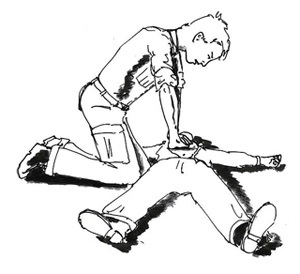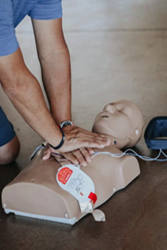Unit 4: Lesson 5: First Aid/Emergency Response
Lesson 5: First Aid/Emergency Response

Lesson 5: First Aid/Emergency Response
Some healthcare issues occur suddenly, requiring immediate forms of treatment. In response to these acute conditions and issues, health science professionals have developed ways of responding to these emergencies until further medical treatment can be obtained. These emergency practices can help health science professionals and everyday people who encounter an emergency.
CPR
Bob is having lunch at a restaurant when the woman beside him falls to the floor. She is not breathing and is unresponsive. What should Bob do?
In situations where a person is unresponsive and not breathing (or only occasionally gasping for air), health science professionals recommend cardiopulmonary resuscitation (CPR) to help the individual. CPR is an emergency procedure that is used to help preserve brain functioning when a person is experiencing cardiac arrest. Although CPR alone does not restart a heart that has stopped beating, it can help keep partially oxygenated blood flowing to the heart and brain until further medical procedures can restore normal functioning.
In 2010, the American Heart Association updated its guidelines for CPR. While full CPR involves both chest compressions and rescue breaths, the AHA recommends that individuals who are not trained in CPR or feel that they are rusty with the skill should only use chest compressions. They also suggested that trained healthcare professionals and others start with chest compressions, doing at least thirty chest compressions before checking the person's airway and administering rescue breaths.
CPR
Before beginning CPR, a health science professional should quickly assess the person to see whether they are conscious or unconscious. In the United States, 911 should be called before beginning CPR unless it appears that the person has become unconscious due to suffocation (a possible drowning would be an example of this). If another person is available, they can call the emergency number while CPR is started.
The AHA recommends that individuals doing CPR concentrate on CAB (compression, airway, breathing) when performing CPR. The steps for performing CPR on an adult include:
- The unresponsive person should be laid on their back on a firm surface.
- Kneel by the person.
- Put the heel of one hand on the person's chest at about the height of the person's nipples. Put your other hand over the first hand, ensuring that your shoulders are directly above your hands and that your elbows are straight.
- Press straight down on your hands for about 5 cm or 2 inches. Aim for 100 chest compressions in one minute.
Aid/Emergency Response
Those not trained in CPR should repeat the steps above. Individuals trained in CPR can continue with the following steps: - Switch from chest compressions to rescue breaths after 30 chest compressions.
- Open the individual's airway by gently tilting the person's head back and the chin pointed up. This can be done by placing your hand on the person's forehead and gently pressing back while the chin is gently guided upward.
- Look for normal breathing, such as the rising chest, breathing sounds, or the feel of a breath on your hand. If no signs are seen after five to ten seconds, or if the person is gasping abnormally, it is time to begin mouth-to-mouth rescue breathing.
- Pinch the nostrils shut after the airway is opened and place your mouth on the person's, creating a seal.
- Give one rescue breath. If the chest rises, give a second breath. If the chest does not rise, you should go back to the step of clearing the airway.
- After two breaths are given, go back to chest compressions. The combination of 30 chest compressions and two rescue breaths is considered one CPR cycle.
- If the person is not responding after five cycles, an automatic external defibrillator (AED) can be used. You should follow the instructions carefully on the AED. If an AED is not available, you should continue with CPR until emergency medical professionals arrive or the person responds.
 The steps above are the CPR procedure for adults. However, children and babies have a slightly different procedure to avoid injury to the child. For a child under eight years of age, only one hand should be used for chest compressions, and you should breathe more gently. The cycle is the same at 30 chest compressions and two rescue breaths. An AED, preferably with pediatric pads, can be used for children according to its directions.
The steps above are the CPR procedure for adults. However, children and babies have a slightly different procedure to avoid injury to the child. For a child under eight years of age, only one hand should be used for chest compressions, and you should breathe more gently. The cycle is the same at 30 chest compressions and two rescue breaths. An AED, preferably with pediatric pads, can be used for children according to its directions.
For infants under one, it is essential to check the airway first. Most cardiac arrests in babies occur due to an airway obstruction or drowning. First aid for choking should be used for children with a known airway obstruction. If the reason is unclear, CPR can be utilized. The baby can be stroked to assess responsiveness to see whether this will elicit a response, but the baby should never be shaken. Chest compressions of about 1.5 inches or 4 centimeters can be performed using two fingers. Gentle puffs should be utilized for the rescue breaths.
